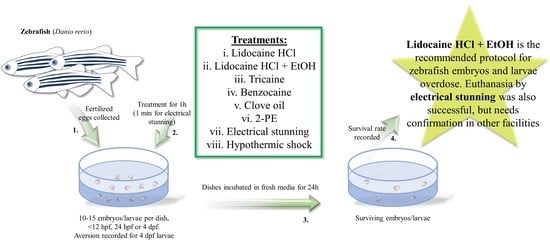A Multi-Site Assessment of Anesthetic Overdose, Hypothermic Shock, and Electrical Stunning as Methods of Euthanasia for Zebrafish (Danio rerio) Embryos and Larvae
Abstract
:Simple Summary
Abstract
1. Introduction
2. Materials and Methods
2.1. Animals and Husbandry
2.2. Experimental Design
2.2.1. Anesthetic Overdose
2.2.2. Electrical Stunning
2.2.3. Hypothermic Shock
2.2.4. Monitoring of Discomfort
2.3. Statistics and Data Presentation
3. Results
4. Discussion
4.1. Anesthetic Overdoses
4.2. Electrical Stunning
4.3. Hypothermic Shock
5. Conclusions
Supplementary Materials
Author Contributions
Funding
Institutional Review Board Statement
Informed Consent Statement
Data Availability Statement
Acknowledgments
Conflicts of Interest
References
- European Union. Directive 2010/63/EU of the European Parliament and of the Council; On the protection of animals used for scientific purposes. Off. J. Eur. Union 2010, 276, 33–79. [Google Scholar]
- Strahle, U.; Scholz, S.; Geisler, R.; Greiner, P.; Hollert, H.; Rastegar, S.; Schumacher, A.; Selderslaghs, I.; Weiss, C.; Witters, H.; et al. Zebrafish embryos as an alternative to animal experiments—A commentary on the definition of the onset of protected life stages in animal welfare regulations. Reprod. Toxicol. 2012, 33, 128–132. [Google Scholar] [CrossRef] [PubMed]
- Mocho, J.-P.; von Krogh, K. A FELASA Survey on Fish Species Used for Research, Methods of Euthanasia, Health Monitoring, and Biosecurity in Europe, North America, and Oceania; Joint Production System Ltd.: Potters Bar, UK, 2022; manuscript in preparation.
- Kelly, J.R.; Benson, S.A. Inconsistent ethical regulation of larval zebrafish in research. J. Fish Biol. 2020, 97, 324–327. [Google Scholar] [CrossRef] [PubMed]
- Lopez-Luna, J.; Al-Jubouri, Q.; Al-Nuaimy, W.; Sneddon, L.U. Impact of analgesic drugs on the behavioural responses of larval zebrafish to potentially noxious temperatures. Appl. Anim. Behav. Sci. 2017, 188, 97–105. [Google Scholar] [CrossRef]
- Lopez-Luna, J.; Al-Jubouri, Q.; Al-Nuaimy, W.; Sneddon, L.U. Impact of stress, fear and anxiety on the nociceptive responses of larval zebrafish. PLoS ONE 2017, 12, e0181010. [Google Scholar] [CrossRef] [PubMed] [Green Version]
- Lopez-Luna, J.; Al-Jubouri, Q.; Al-Nuaimy, W.; Sneddon, L.U. Reduction in activity by noxious chemical stimulation is ameliorated by immersion in analgesic drugs in zebrafish. J. Exp. Biol. 2017, 220, 1451–1458. [Google Scholar] [CrossRef] [PubMed] [Green Version]
- Collymore, C.; Banks, E.K.; Turner, P.V. Lidocaine hydrochloride compared with MS222 for the euthanasia of zebrafish (Danio rerio). J. Am. Assoc. Lab. Anim. Sci. 2016, 55, 816–820. [Google Scholar] [PubMed]
- Lidster, K.; Readman, G.D.; Prescott, M.J.; Owen, S. International survey on the use and welfare of zebrafish Danio rerio in research. J. Fish Biol. 2017, 90, 1891–1905. [Google Scholar] [CrossRef] [Green Version]
- Readman, G.D.; Owen, S.; Murrell, J.C.; Knowles, T. Do fish perceive anaesthetics as aversive? PLoS ONE 2013, 8, e73773. [Google Scholar] [CrossRef] [PubMed] [Green Version]
- Sánchez-Vázquez, F.J.; Terry, M.I.; Felizardo, V.O.; Vera, L.M. Daily rhythms of toxicity and effectiveness of anesthetics (MS222 and eugenol) in zebrafish (Danio rerio). Chronobiol. Int. 2011, 28, 109–117. [Google Scholar] [CrossRef]
- Wilson, J.M.; Bunte, R.M.; Carty, A.J. Evaluation of rapid cooling and tricaine methanesulfonate (MS222) as methods of euthanasia in zebrafish (Danio rerio). J. Am. Assoc. Lab. Anim. Sci. 2009, 48, 785–789. [Google Scholar] [PubMed]
- Wong, D.; Von Keyserlingk, M.A.G.; Richards, J.G.; Weary, D.M. Conditioned place avoidance of zebrafish (Danio rerio) to three chemicals used for euthanasia and anaesthesia. PLoS ONE 2014, 9, e88030. [Google Scholar] [CrossRef] [PubMed] [Green Version]
- Schroeder, P.; Lloyd, R.; McKimm, R.; Metselaar, M.; Navarro, J.; O’Farrell, M.; Readman, G.D.; Speilberg, L.; Mocho, J.-P. Anaesthesia of laboratory, aquaculture and ornamental fish: Proceedings of the first LASA-FVS Symposium. Lab. Anim. 2021, 55, 317–328. [Google Scholar] [CrossRef] [PubMed]
- Rombough, P.J. Ontogenetic changes in the toxicity and efficacy of the anaesthetic MS222 (tricaine methanesulfonate) in zebrafish (Danio rerio) larvae. Comp. Biochem. Physiol. A Mol. Integr. Physiol. 2007, 148, 463–469. [Google Scholar] [CrossRef] [PubMed]
- Anders, N.; Roth, B.; Grimsbo, E.; Breen, M. Assessing the effectiveness of an electrical stunning and chilling protocol for the slaughter of Atlantic mackerel (Scomber scombrus). PLoS ONE 2019, 14, e0222122. [Google Scholar] [CrossRef]
- Boyland, N. The Welfare of Farmed Fish during Slaughter in the European Union; Compassion in World Farming International: Godalming, UK, 2018. [Google Scholar]
- European Food Safety Authority. Opinion of the Scientific Panel on Animal Health and Welfare on a request from the Commission related to welfare aspects of the main systems of stunning and killing the main commercial species of animals. EFSA J. 2004, 45, 1–29. [Google Scholar]
- Lambooij, E.; Kloosterboer, R.J.; Gerritzen, M.A.; Van De Vis, J.W. Assessment of electrical stunning in fresh water of African Catfish (Clarias gariepinus) and chilling in ice water for loss of consciousness and sensibility. Aquaculture 2006, 254, 388–395. [Google Scholar] [CrossRef]
- Lines, J.; Kestin, S. Electrical stunning of fish: The relationship between the electric field strength and water conductivity. Aquaculture 2004, 241, 219–234. [Google Scholar] [CrossRef] [Green Version]
- American Veterinary Medical Association. AVMA Guidelines for the Euthanasia of Animals, 2020 Edition; American Veterinary Medical Association: Schaumburg, IL, USA, 2020. [Google Scholar]
- Wallace, C.K.; Bright, L.A.; Marx, J.O.; Andersen, R.P.; Mullins, M.C.; Carty, A.J. Effectiveness of rapid cooling as a method of euthanasia for young zebrafish (Danio rerio). J. Am. Assoc. Lab. Anim. Sci. 2018, 57, 58–63. [Google Scholar] [PubMed]
- European Commission. 2019 Report on the Statistics on the Use of Animals for Scientific Purposes in the Member States of the European Union in 2015–2017; Report from the Commission to the European Parliament and the Council; Report No. COM(2020) 16 Final; European Commission: Brussels, Belgium, 2020. [Google Scholar]
- Kinth, P.; Mahesh, G.; Panwar, Y. Mapping of zebrafish research: A global outlook. Zebrafish 2013, 10, 510–517. [Google Scholar] [CrossRef] [PubMed] [Green Version]
- Kimmel, C.B.; Ballard, W.W.; Kimmel, S.R.; Ullmann, B.; Schilling, T.F. Stages of embryonic development of the zebrafish. Dev. Dyn. 1995, 203, 253–310. [Google Scholar] [CrossRef] [PubMed]
- Von Krogh, K.; Higgins, J.; Saavedra Torres, Y.; Mocho, J.-P. Screening of anaesthetics in adult zebrafish (Danio rerio) for the induction of euthanasia by overdose. Biology 2021, 10, 1133. [Google Scholar] [CrossRef]
- Lawrence, C.; Eisen, J.S.; Varga, Z.M. Husbandry and Health Program Survey Synopsis. Zebrafish 2016, 13 (Suppl. 1), S5–S7. [Google Scholar] [CrossRef] [Green Version]
- Crim, M.J.; Lawrence, C. A fish is not a mouse: Understanding differences in background genetics is critical for reproducibility. Lab. Anim. 2021, 50, 19–25. [Google Scholar] [CrossRef]
- Matthews, M.; Varga, Z.M. Anesthesia and euthanasia in zebrafish. Ilar. J. 2012, 53, 192–204. [Google Scholar] [CrossRef] [PubMed] [Green Version]
- Strykowski, J.L.; Schech, J.M. Effectiveness of recommended euthanasia methods in larval zebrafish (Danio rerio). J. Am. Assoc. Lab. Anim. Sci. 2015, 54, 81–84. [Google Scholar] [PubMed]
- Rombough, P. Gills are needed for ionoregulation before they are needed for O2 uptake in developing zebrafish, Danio rerio. J. Exp. Biol. 2002, 205, 1787–1794. [Google Scholar] [CrossRef] [PubMed]
- Fagerber, J.H.; Al-Tikriti, Y.; Ragnarsson, G.; Bergstrom, C.A. Ethanol effects on apparent solubility of poorly soluble drugs in simulated intestinal fluid. Mol. Pharm. 2012, 9, 1942–1952. [Google Scholar] [CrossRef]
- Ali, S.; Champagne, D.L.; Alia, A.; Richardson, M.K. Large-scale analysis of acute ethanol exposure in zebrafish development: A critical time window and resilience. PLoS ONE 2011, 6, e20037. [Google Scholar] [CrossRef] [PubMed] [Green Version]
- Zhang, C.; Frazier, J.M.; Chen, H.; Liu, Y.; Lee, J.-A.; Cole, G.J. Molecular and morphological changes in zebrafish following transient ethanol exposure during defined developmental stages. Neurotoxicol. Teratol. 2014, 44, 70–80. [Google Scholar] [CrossRef] [Green Version]
- Davis, D.J.; Klug, J.; Hankins, M.; Doerr, H.M.; Monticelli, S.R.; Song, A.; Gillespie, C.H.; Bryda, E.C. Effects of clove oil as a euthanasia agent on blood collection efficiency and serum cortisol levels in Danio rerio. J. Am. Assoc. Lab. Anim. Sci. 2015, 54, 564–567. [Google Scholar] [PubMed]
- Grush, J.; Noakes, D.L.G.; Moccia, R.D. The efficacy of clove oil as an anesthetic for the zebrafish, Danio rerio (Hamilton). Zebrafish 2004, 1, 46–53. [Google Scholar] [CrossRef] [PubMed] [Green Version]
- Gerlai, R. Reproducibility and replicability in zebrafish behavioral neuroscience research. Pharm. Biochem. Behav. 2019, 178, 30–38. [Google Scholar] [CrossRef]
- Gross, J.; Farokhkish, B.; Cornacione, M.; Shaw, S.; Nguyen, P.L.; Henty, T.B. Potential use of direct current electric fields to eradicate rainbow trout embryos from freshwater ecosystems. North Am. J. Fish. Manag. 2015, 35, 871–879. [Google Scholar] [CrossRef]
- Beaumont, W.R.C. Electricity in Fish Research and Management: Theory and Practice; Wiley-Blackwell: Hoboken, NJ, USA, 2016. [Google Scholar]
- Chen, K.; Wang, C.Q.; Fan, Y.Q.; Xie, Y.S.; Yin, Z.F.; Xu, Z.J.; Zhang, H.L.; Cao, J.T.; Han, Z.H.; Wang, Y.; et al. The evaluation of rapid cooling as an anesthetic method for the zebrafish. Zebrafish 2014, 11, 71–75. [Google Scholar] [CrossRef] [PubMed]

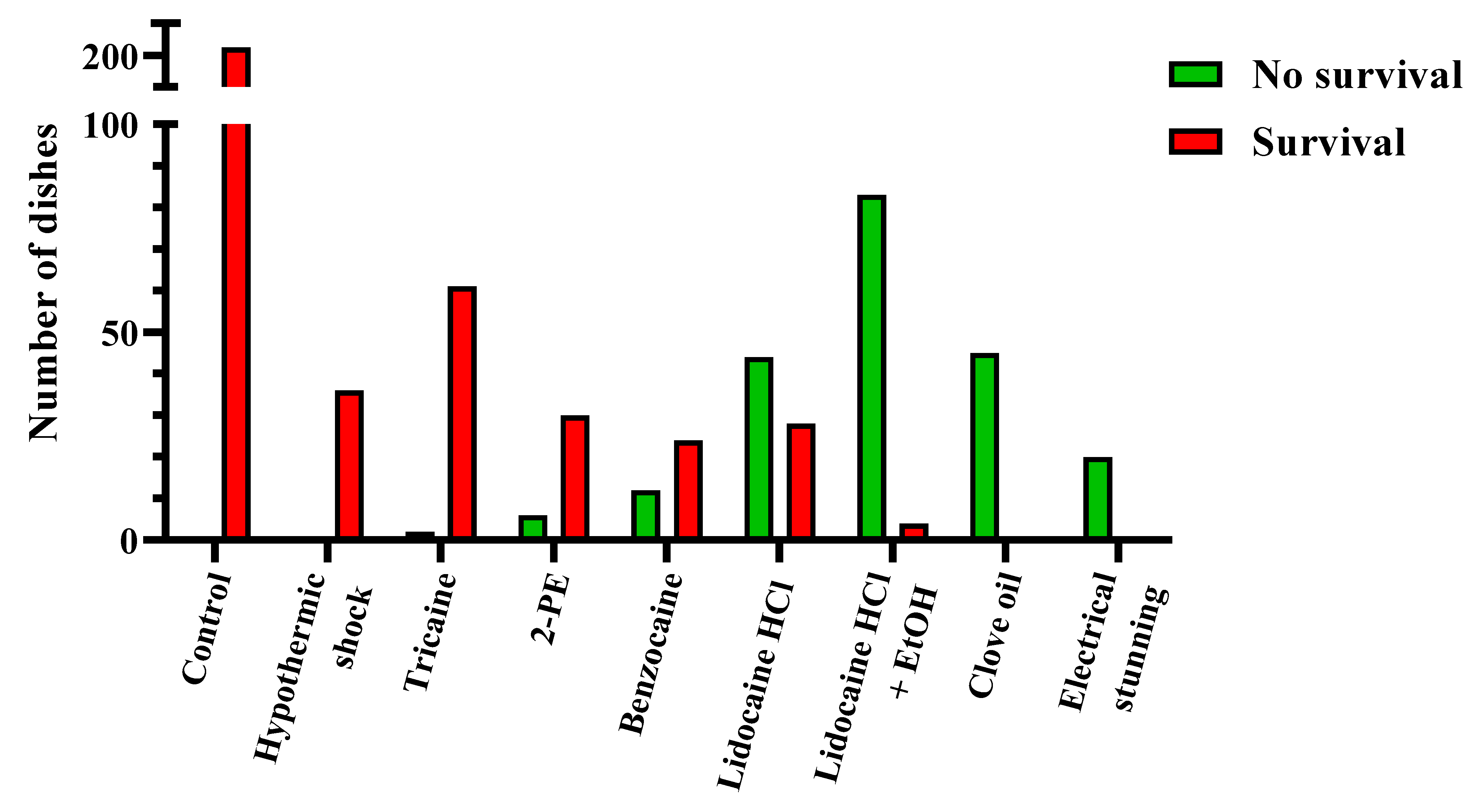
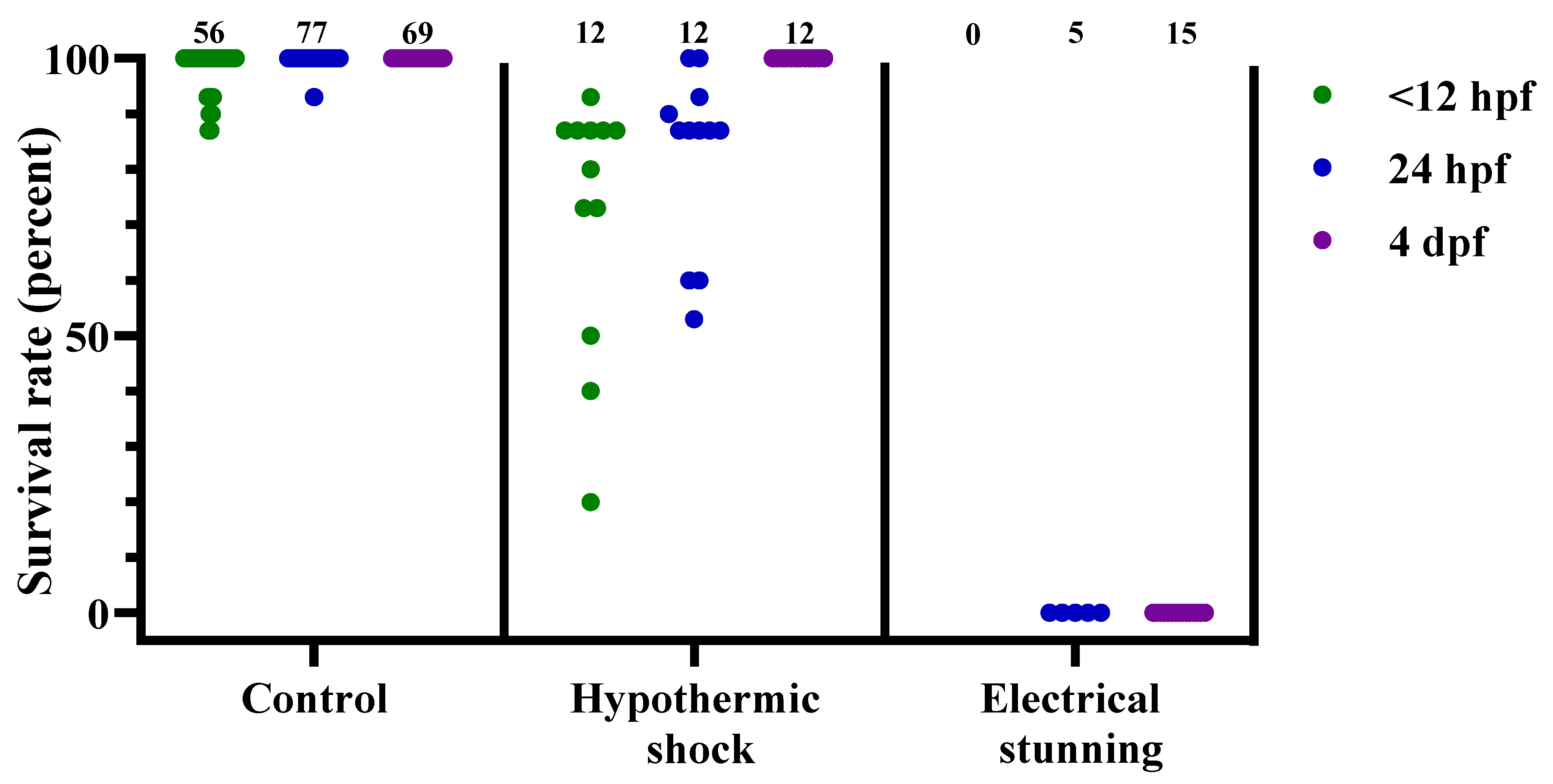
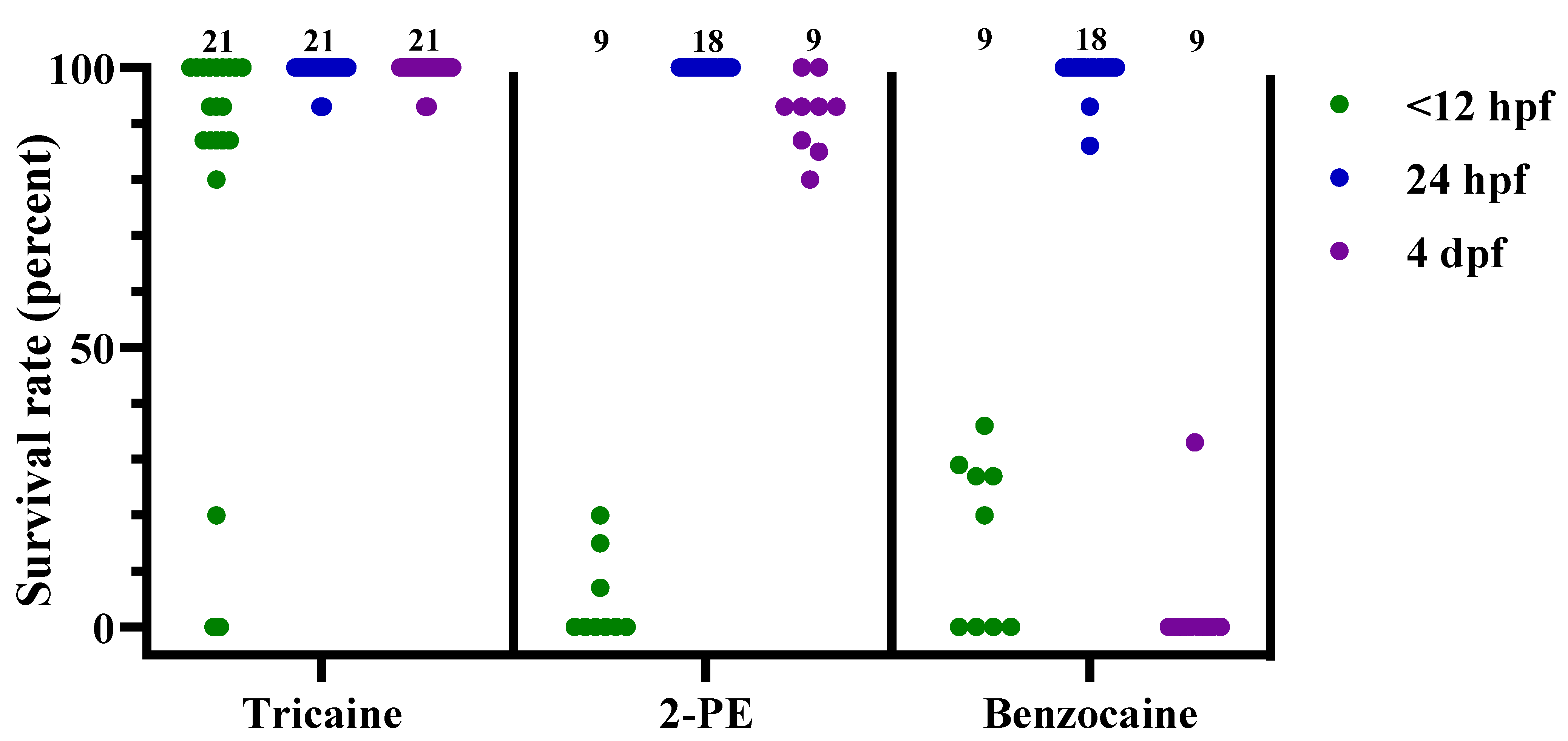
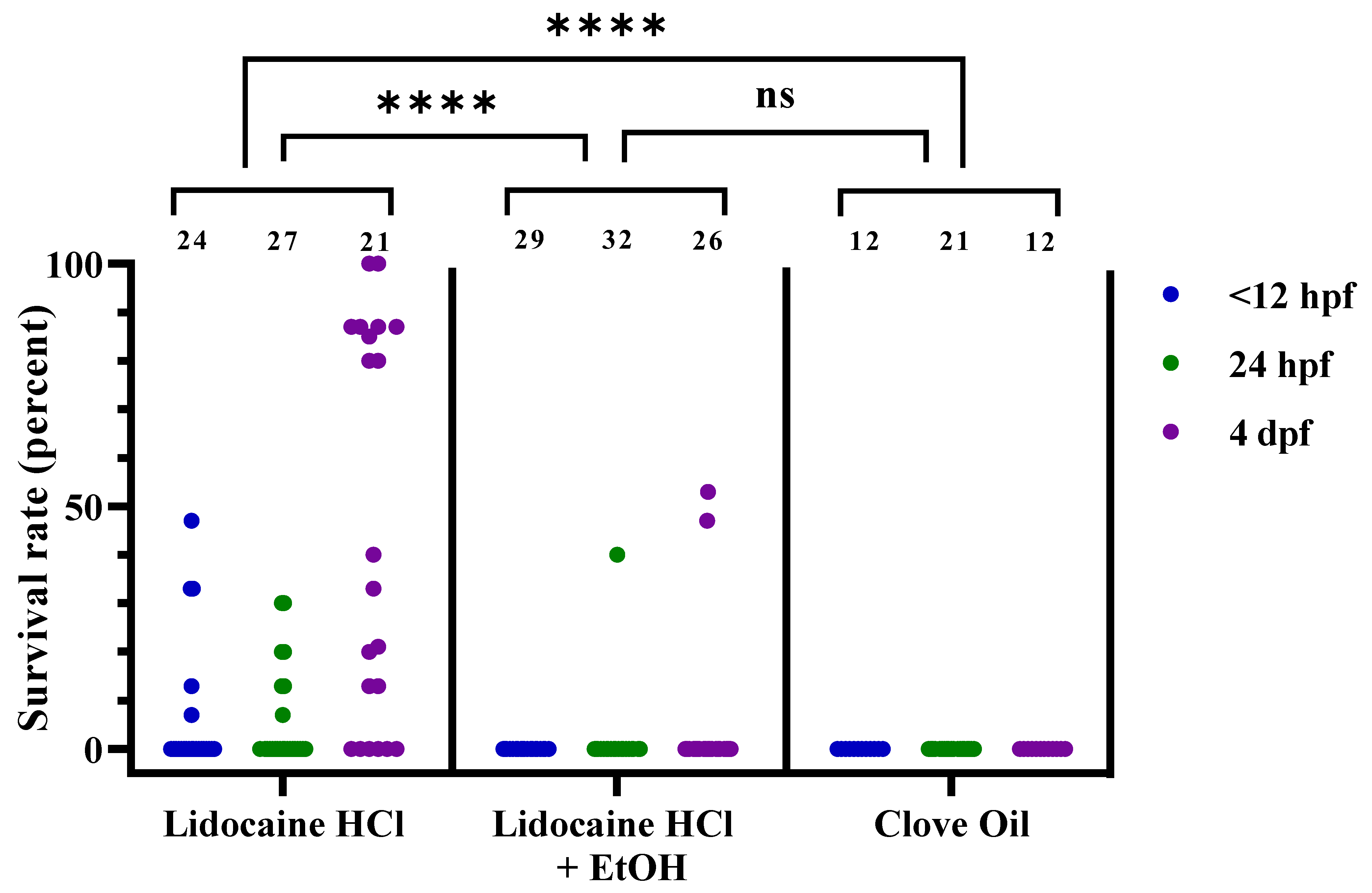
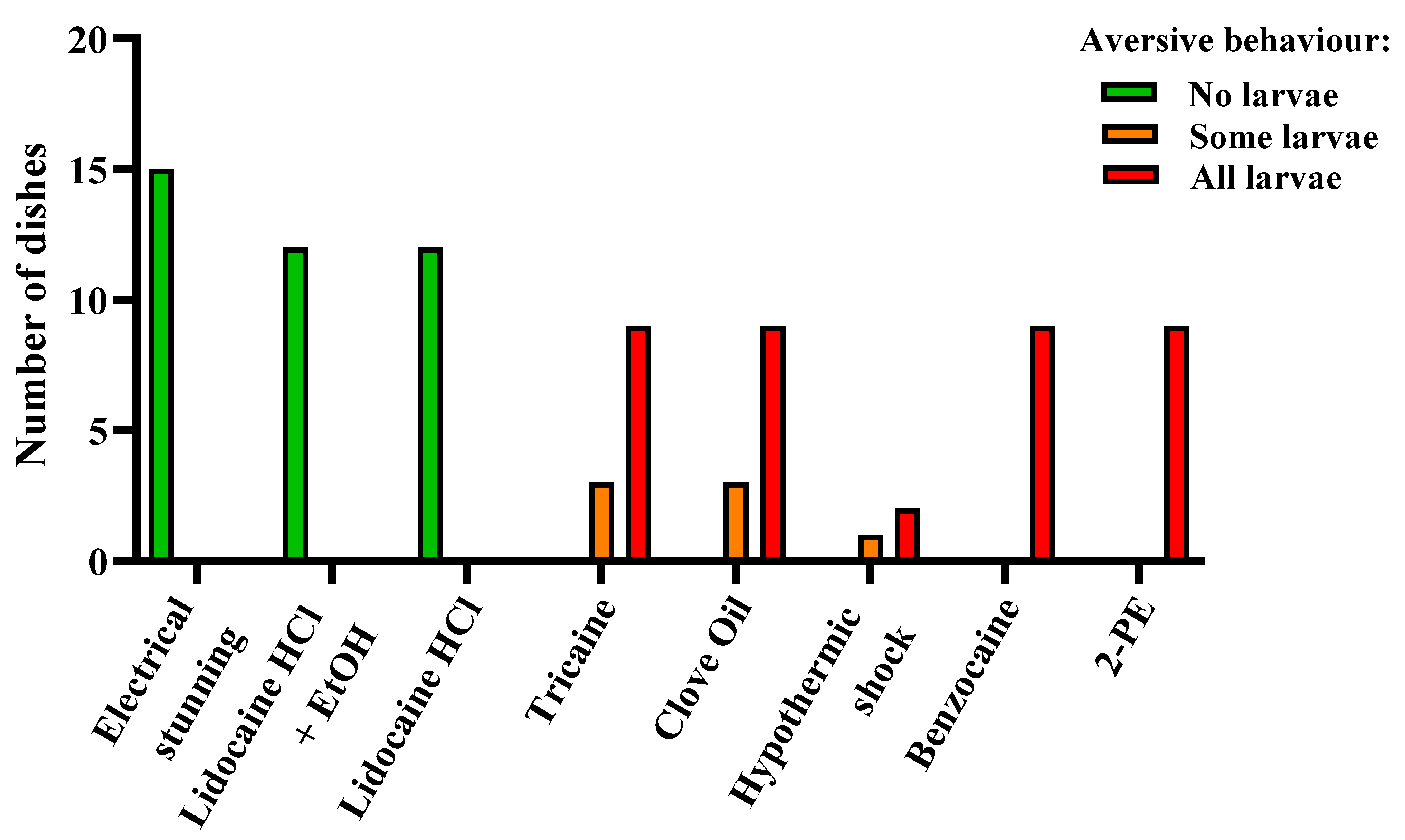
| Name: | Location: | Website: |
|---|---|---|
| Ecole Polytechnique Fédérale de Lausanne (EPFL) | Lausanne, Switzerland | www.epfl.ch/en/ |
| The Francis Crick Institute (FCI) | London, United Kingdom | www.crick.ac.uk/ |
| Institut Pasteur (IP) | Paris, France | www.pasteur.fr/en |
| University of Copenhagen (KU) | Copenhagen, Denmark | www.sund.ku.dk/ |
| Instituto de Investigaciones Marinas (IIM) | Vigo, Spain | www.iim.csic.es/ |
| Universitat Autònoma de Barcelona (UAB) | Barcelona, Spain | www.uab.cat/en/ |
| Generic Name | Active Chemical | Product Name | Manufacturer |
|---|---|---|---|
| 2-Phenoxyethanol (2-PE) | 2-Phenoxyethanol | 2-Phenoxyethanol (77699) Aqua-Sed | SIGMA-ALDRICH (U.S.A.) VETARK (Winchester, U.K.) |
| Benzocaine | Ethyl 4-aminobenzoate | Benzocaine (E1501) | SIGMA-ALDRICH (U.S.A.) |
| Clove oil | 2-Methoxy-4-(prop-2-en-1-yl)phenol (i.e., eugenol) and others unidentified | Clove oil (C8392) Essential clove oil (2215 lab 122735) | SIGMA-ALDRICH (U.S.A.) SOL NATURA (Spain) |
| Lidocaine hydrochloride (HCl) | 2-(diethylamino)-N-(2,6- dimethylphenyl)acetamide hydrochloride monohydrate | Lidocaine hydrochloride monohydrate (L5647) | SIGMA-ALDRICH (U.S.A.) |
| Tricaine (MS222) | Ethyl 3-aminobenzoate methanesulfonate | Ethyl 3-aminobenzoate methanesulfonate (E10521) Ethyl 3-aminobenzoate methanesulfonate salt (A5040) | SIGMA-ALDRICH (U.S.A.) SIGMA-ALDRICH (U.S.A.) |
| Sodium bicarbonate (NaHCO3) | NaHCO3 | Sodium bicarbonate (S5761) | SIGMA-ALDRICH (U.S.A.) |
| Agent | Dose |
|---|---|
| Lidocaine hydrochloride (HCl) | 1 g/L + 2 g/L NaHCO3 |
| Lidocaine HCl + ethanol (EtOH) | 1 g/L + 2 g/L NaHCO3 + 50 mL/L EtOH |
| Clove oil | 0.1% (1:10 in EtOH, then 10 mL/L) |
| Tricaine | 1 g/L + 2 g/L NaHCO3 |
| Benzocaine | 1 g /L (20 g/L in EtOH, then 50 mL/L) |
| 2-Phenoxyethanol (2-PE) | 3 mL/L |
| Treatment | Timepoint | Dishes | % Passed | |||
|---|---|---|---|---|---|---|
| Passed | Failed | Total | Time Point | Treatment | ||
| Control | <12 hpf | 0 | 56 | 56 | 0% | 0% |
| 24 hpf | 0 | 77 | 77 | 0% | ||
| 48 h | 0 | 3 | 3 | 0% | ||
| 4 dpf | 0 | 69 | 69 | 0% | ||
| Hypothermic shock | <12 hpf | 0 | 12 | 12 | 0% | 0% |
| 24 hpf | 0 | 12 | 12 | 0% | ||
| 4 dpf | 0 | 12 | 12 | 0% | ||
| Tricaine | <12 hpf | 2 | 19 | 21 | 10% | 3% |
| 24 hpf | 0 | 21 | 21 | 0% | ||
| 4 dpf | 0 | 21 | 21 | 0% | ||
| 2-phenoxyethanol | <12 hpf | 6 | 3 | 9 | 67% | 22% |
| 24 hpf | 0 | 18 | 18 | 0% | ||
| 4 dpf | 0 | 9 | 9 | 0% | ||
| Benzocaine | <12 hpf | 4 | 5 | 9 | 44% | 44% |
| 24 hpf | 0 | 18 | 18 | 0% | ||
| 4 dpf | 8 | 1 | 9 | 89% | ||
| Lidocaine HCl | <12 hpf | 19 | 5 | 24 | 79% | 61% |
| 24 hpf | 19 | 8 | 27 | 70% | ||
| 48 h | 2 | 1 | 3 | 67% | ||
| 4 dpf | 6 | 15 | 21 | 29% | ||
| Lidocaine HCL + EtOH | <12 hpf | 29 | 0 | 29 | 100% | 96% |
| 24 hpf | 31 | 1 | 32 | 97% | ||
| 48 h | 3 | 0 | 3 | 100% | ||
| 4 dpf | 23 | 3 | 26 | 88% | ||
| Clove oil | <12 hpf | 12 | 0 | 12 | 100% | 100% |
| 24 hpf | 21 | 0 | 21 | 100% | ||
| 4 dpf | 12 | 0 | 12 | 100% | ||
| Electrical stunning | 24 hpf | 5 | 0 | 5 | 100% | 100% |
| 4 dpf | 15 | 0 | 15 | 100% | ||
Publisher’s Note: MDPI stays neutral with regard to jurisdictional claims in published maps and institutional affiliations. |
© 2022 by the authors. Licensee MDPI, Basel, Switzerland. This article is an open access article distributed under the terms and conditions of the Creative Commons Attribution (CC BY) license (https://creativecommons.org/licenses/by/4.0/).
Share and Cite
Mocho, J.-P.; Lang, F.; Valentin, G.; Bedu, S.; McKimm, R.; Ramos, J.; Saavedra Torres, Y.; Wheatley, S.E.; Higgins, J.; Millington, M.E.; et al. A Multi-Site Assessment of Anesthetic Overdose, Hypothermic Shock, and Electrical Stunning as Methods of Euthanasia for Zebrafish (Danio rerio) Embryos and Larvae. Biology 2022, 11, 546. https://doi.org/10.3390/biology11040546
Mocho J-P, Lang F, Valentin G, Bedu S, McKimm R, Ramos J, Saavedra Torres Y, Wheatley SE, Higgins J, Millington ME, et al. A Multi-Site Assessment of Anesthetic Overdose, Hypothermic Shock, and Electrical Stunning as Methods of Euthanasia for Zebrafish (Danio rerio) Embryos and Larvae. Biology. 2022; 11(4):546. https://doi.org/10.3390/biology11040546
Chicago/Turabian StyleMocho, Jean-Philippe, Florian Lang, Guillaume Valentin, Sébastien Bedu, Robin McKimm, Juan Ramos, Yolanda Saavedra Torres, Sarah E. Wheatley, Joseph Higgins, Mollie E. Millington, and et al. 2022. "A Multi-Site Assessment of Anesthetic Overdose, Hypothermic Shock, and Electrical Stunning as Methods of Euthanasia for Zebrafish (Danio rerio) Embryos and Larvae" Biology 11, no. 4: 546. https://doi.org/10.3390/biology11040546
APA StyleMocho, J.-P., Lang, F., Valentin, G., Bedu, S., McKimm, R., Ramos, J., Saavedra Torres, Y., Wheatley, S. E., Higgins, J., Millington, M. E., Lundegaard, P. R., Chamorro Valverde, R., Jenčič, V., & von Krogh, K. (2022). A Multi-Site Assessment of Anesthetic Overdose, Hypothermic Shock, and Electrical Stunning as Methods of Euthanasia for Zebrafish (Danio rerio) Embryos and Larvae. Biology, 11(4), 546. https://doi.org/10.3390/biology11040546






